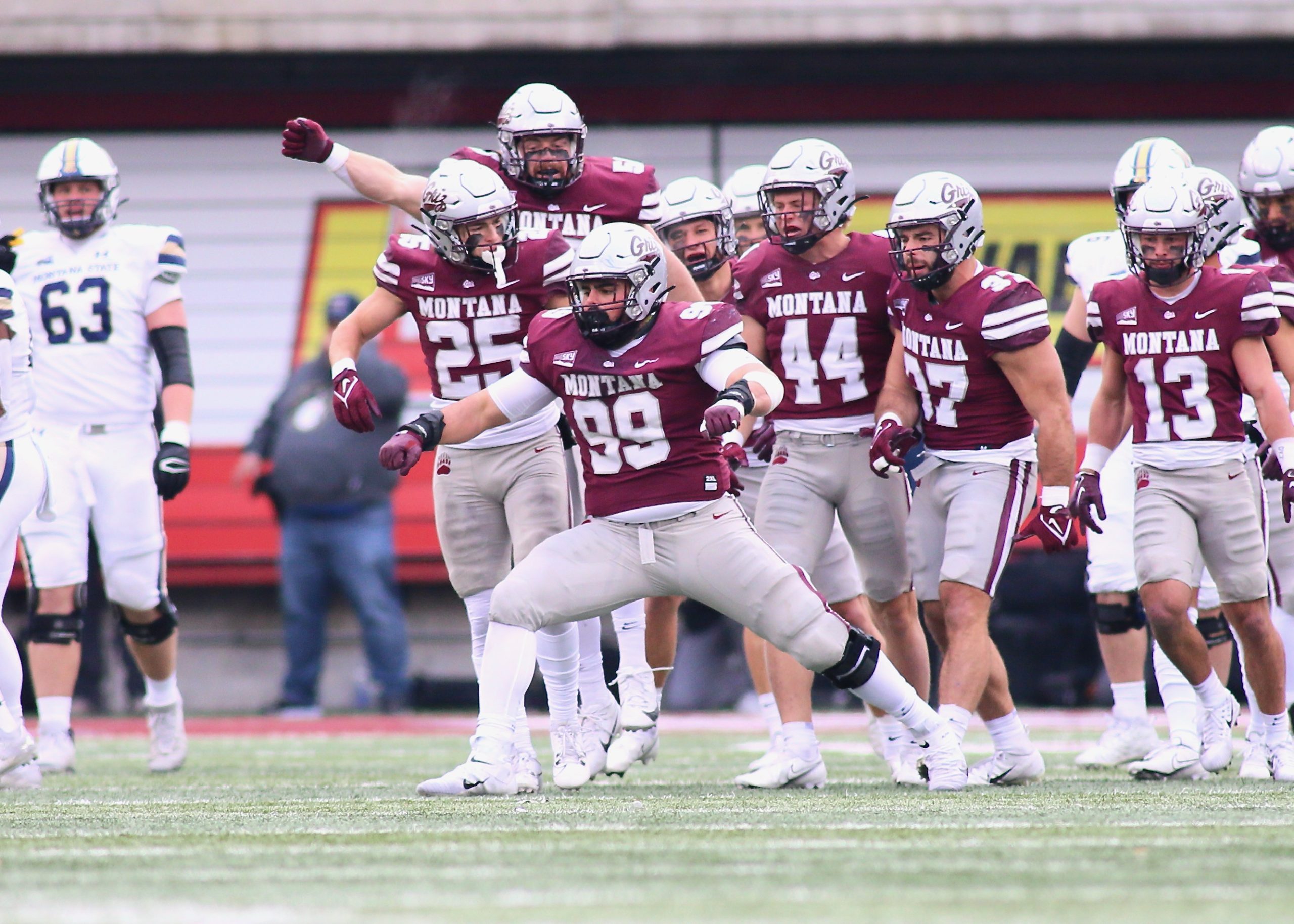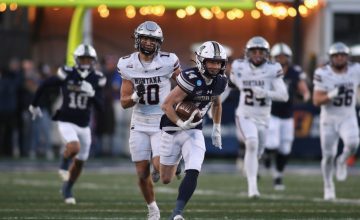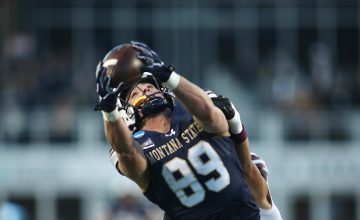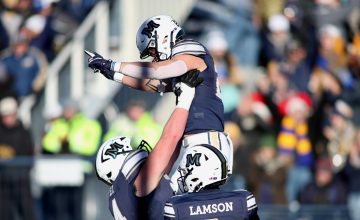Despite playing in different conferences, Montana and South Dakota State have had plenty of common opponents over the past few years between non-conference schedules and playoff meetings. To get the inside scoop on what we’ll see on the field on Sunday, Skyline Sports reached out to multiple coaches and coordinators who have played against Montana and South Dakota State in the past few years for an anonymous scouting report. This, from the coaches who have played them, is the definitive scouting report on the Grizzlies’ and Jackrabbits’ defense. A companion report on the offenses will be published later today.
One offensive coach who game planned against both the Jackrabbits and the Grizzlies in the past few years broke down the respective defenses this way.
“Montana is very exotic. You’re gonna get so many different pressures and fronts, coverages, all that stuff,” he said. “South Dakota State, they are less exotic. Their base defense is quarters defense, with a lot of built-in answers. It’s probably going to be a great, great battle. Montana’s defense, they’re going to give you a lot of headaches and make you prepare for a lot of different things. South Dakota State, you’re obviously going to have to prepare for a bunch, but you’re definitely going to see less fronts and probably fewer coverages for South Dakota State.”
South Dakota State head coach Jimmy Rogers was the Jackrabbits’ defensive coordinator in 2022 before taking the head job, and the co-DC for the three seasons before that. His signature quarters, or Cover 4, defense has helped lift SDSU to lofty heights.
“Jimmy, without question, is one of the best, if not the best, defensive minds in FCS football, and probably across the country,” said the same coach. “He’s impressive. They’re a four-down quarters defense, where their defense ends are B-gap players and they just condense the box. What they want to do is stop the run and if they give up some pass yards, they still think they’re gonna win the game. I think they’re still going to be happy. But obviously they have guys on the edge, corners that can play man coverage.”

Heading into the title game, SDSU is second in the nation in rush defense – but also seventh in pass defense, and the Jackrabbits lead the country in total defense by both yardage and scoring. The ‘Jacks are trying to become just the third FCS team ever to finish giving up less than 10 points per game in a single season.
“South Dakota State, they’re just so well-coached,” said a different offensive coordinator who faced off with the Jackrabbits. “Jimmy plays that quarters defense. I think quarters is the toughest defense to do anything against. It’s high risk, high reward for defenses. So if you do it well and you have the horses, you can play it well, it’s suffocating, which is what the Jacks have done. They did a really good job of dialing up tendencies that we had based on down and distance. Jimmy’s going to be way into Pro Football Focus, he’s gonna have all the stats ready to go. He’s gonna know their tendencies in every situation.”
That coach continued: “It’s going to be a team that is as physically talented as Montana, playing really good one-gap defense that’s going to understand what Montana’s tendencies are. They’re going to spill some stuff to the perimeter. A lot of the interior run game is going to be very, very hard to come by. The defensive ends, they’re B-gap players, so even though they line up outside the tackle, they’re going to try and blow that tackle into the B gap to make that as small as possible and force everything to the perimeter.
“I wouldn’t be surprised to see Montana use some power-read stuff with (Clifton McDowell) or fly sweep with (Junior Bergen). Those are probably viable things for them and then you gotta have play-action off of that. The downhill run they’re not as worried about, so the play-action off of it is harder just because they trust the scheme and they’re so gap sound, but when you can get that lateral movement stuff – your naked (bootlegs), your counter bootlegs – things like that are usually a little bit more effective. And then for your run game you have to have a perimeter element and read it to be effective.”
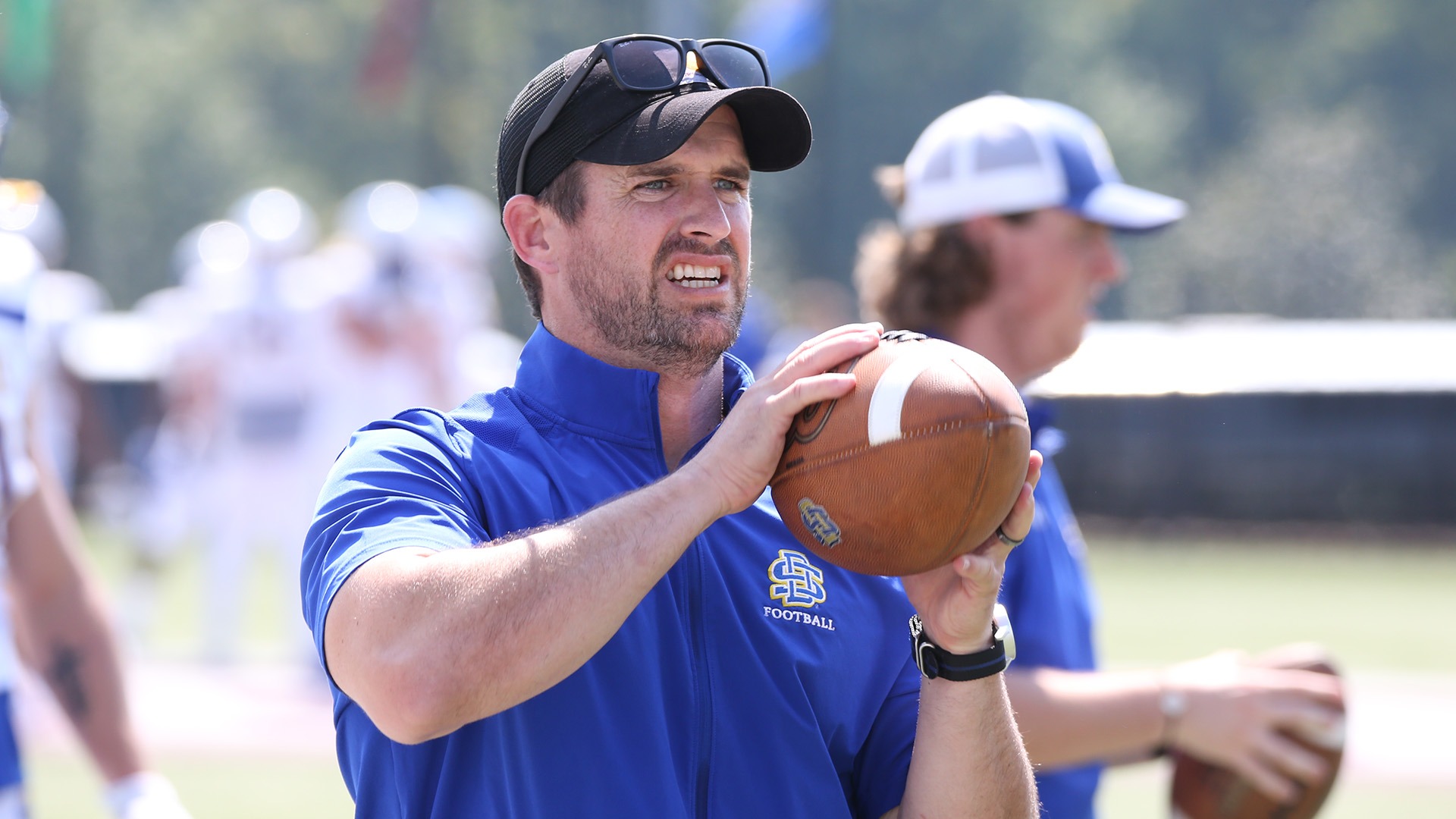
Senior linebackers Jason Freeman and Isaiah Stalbird led SDSU in tackles with 96 and 75, respectively, while two-time MVFC first-teamer Adam Bock missed time with injury but still had over 50 tackles. Freeman, defensive lineman Cade Terveer (just 20 tackles but a team-high 7.5 for loss) and defensive back Tucker Large (43 tackles, four interceptions) made the all-conference first team. Stalbird, defensive tackle Ryan Van Marel and defensive back Dyshawn Gales were on the second team.
“I thought their personnel was really good,” said our second anonymous coach. “They’re strong, long and they play the responsibilities really well. … They’re a quarters team, so they want to play a lot of variations of shell zone, whether it’s cover six and clouding the boundary or the field, they’ll cloud both sides. They don’t ever want to get totally into Cover 2 unless it’s a tempo situation, just because the quarter shell is so important to their run fits, having those safeties be able to be involved. On the secondary, I always felt like they were long and good and played to their help, but I felt like we could beat them in one-on-ones. The big plays we had against them were double moves in the secondary, or some variation of four verticals where our quarterback just threw a seed.”
The one area where South Dakota State’s defense isn’t above-average is the pass rush, which this coach also noted. The Jackrabbits average 1.71 sacks per game, 77th in the country.
“They’re not elite pass rushers. They’ll try to walk you back to the quarterback, but I think their game is not necessarily creating schematic sacks. If Jimmy wants to generate pressure, he’s going to have to bring more than the front four, and the front four is not elite from a pressure standpoint, unless they really can get you in third-and-long or must-pass situations where they can pin their ears back and funk it up.”
Montana’s defense, on the other hand, is all about funk.
“Our deal going into Montana was, they’re gonna give you every single defensive front under the sun,” said the first coach. “I mean, you’re gonna see odd, you’re gonna see even, you’re gonna see different types of odd. You’re gonna see every single pressure. You’re gonna get blitzed, you’re gonna get five or six (rushers) regularly, so you have to be able to handle that where you’re solid across from gap to gap.”
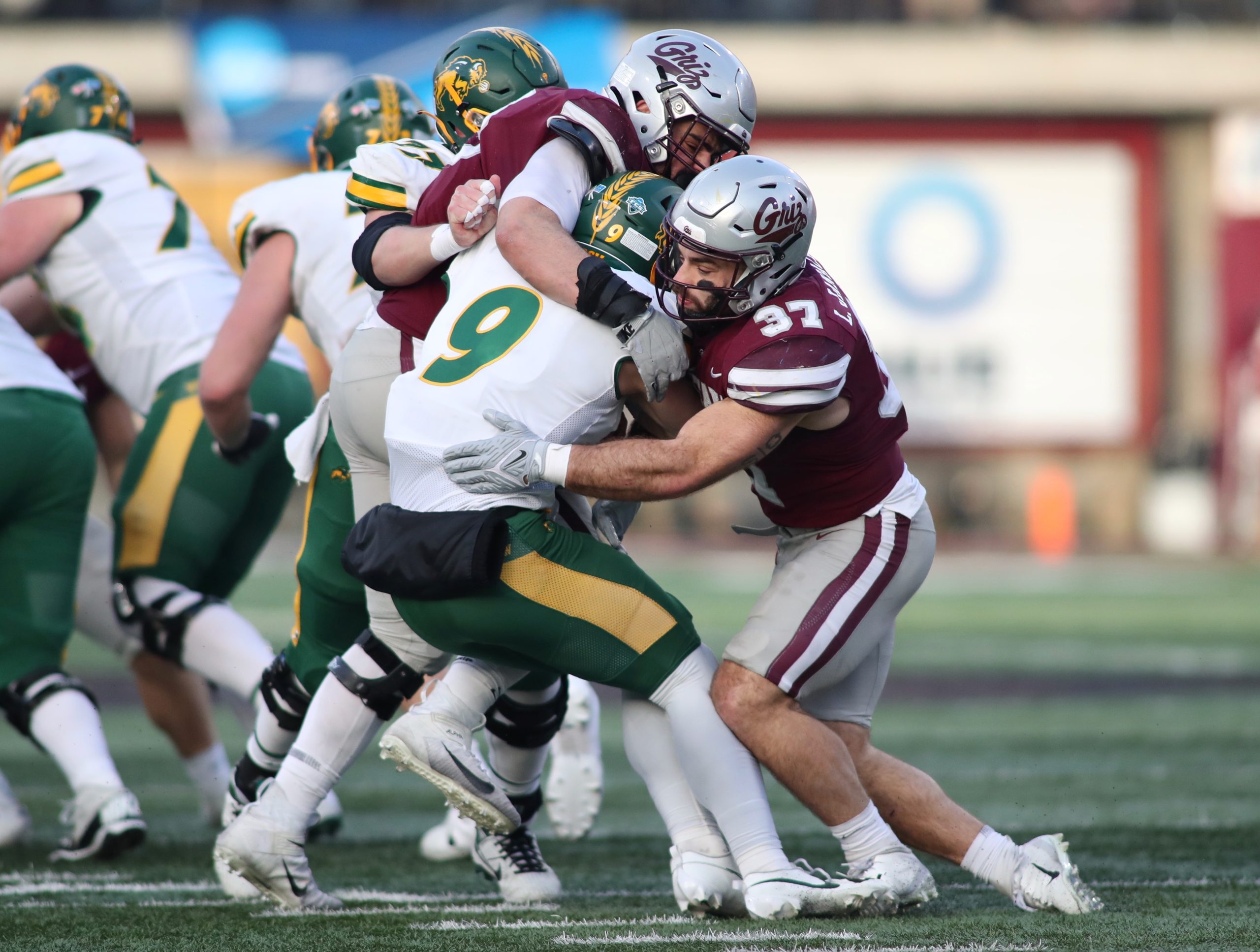
The big story on Montana’s defense this year was Ronnie Bradford taking over for Kent Baer as defensive coordinator. Skyline Sports wrote early in the year about how the change led to the Griz being more diverse in their coverage schemes, something that our second anonymous coach also noted in depth.
“I thought they did a much better job this year of just being multiple, you know, I don’t know if that was a decision from the top down or if it was a Baer thing,” he said. “The whole Rocky Long defense, it’s funky, but if you study it for a while, like an off season, you’re gonna be able to figure it out. And that’s kind of where I think you saw you know, Montana State have their way with them for a while, because if you’re going to stick in 3-3-5 personnel, you have no answer for the wing run game, particularly when you add the quarterback into it. I say wing as in, you know, it’s like two tight ends on one side set. That’s how you would get after Montana in the run game. Montana State did it better than everybody else. And (Montana) never changed their personnel up and they never changed their scheme. They were just trying to be Montana, which is fine.
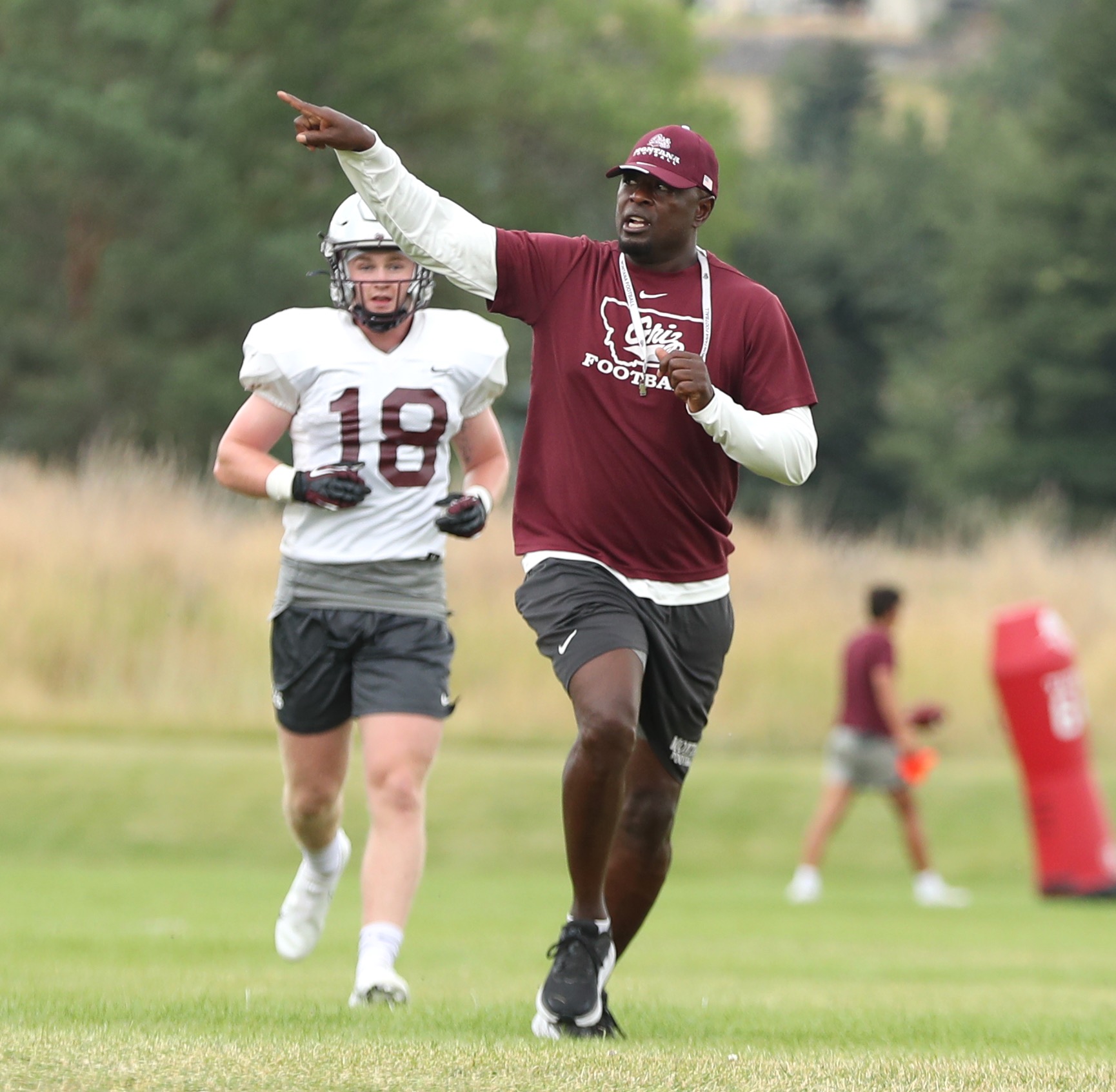
“But this year, hey, the personnel on the field is the same. They’re playing aggressive and fast, twisting, and they’re making one-on-ones and combo blocks virtually impossible just because of how much they move. But they played way more Cover 3. I think anytime you play Cover 3, you always have to understand how you’re going to handle the field curl-flat. They’ve done a lot more stuff where that nickel or field safety will get up and press the Number 2 (inside) receiver, so he’ll kind of eliminate that, whereas in the past they used to play off so you could work a lot of your curl-flat games or your smash games.
“They’re eliminating the free access stuff to the field, and they’ve created the same amount of chaos in the box. But instead of being in that 3-3-5 shell where you’re going to get seven guys in the fit, they’re playing more Cover 3 where you can get eight guys in the fit, so it’s been harder to run the ball on them. It’s probably been a little bit easier to get the short runs, harder to get the gashers just because they have more fitters there.”
That coach compared the Grizzlies’ new look to one of the famous NFL defenses of the last 20 years.
“Cover 3 is the bend-but-don’t-break defense that the Seattle Seahawks got really famous with,” he said. “I think when you’re always living in quarters, it’s great when it’s good and really bad when it’s bad. Cover 3 is never going to be bad. So they’ve allowed themselves to be a little bit more consistent on defense. And then when teams start to press, all that twisting is tough to handle. They’re eliminating the field receivers with a variety of coverages and pressing the field too.
“The only real success throwing the football was attacking the boundary. You’ll see a lot of teams, if you watch tape of how people try to attack the Griz, they’re going to get formation boundary to try and make No. 13 (Ryder Meyer) the boundary safety. He’s a good player, but he’s the guy you want to throw at, just try to get two (receivers) out to the boundary to make him have to cover.”
As far as personnel, both coaches mentioned Montana’s defensive tackle Alex Gubner, the Big Sky Defensive Player of the Year and a first-team All-American.
“It makes it really hard when they have a guy like Number 99 (Gubner),” the first coach said. “So we were like, well, we can’t just straight up run zone on them. We tried to put in a couple of plays that allowed us to get outside and attack the C and the D gap a little bit. You’re gonna have to have an answer for 99, because that guy, you can’t just run straight at him, it’s near impossible.”
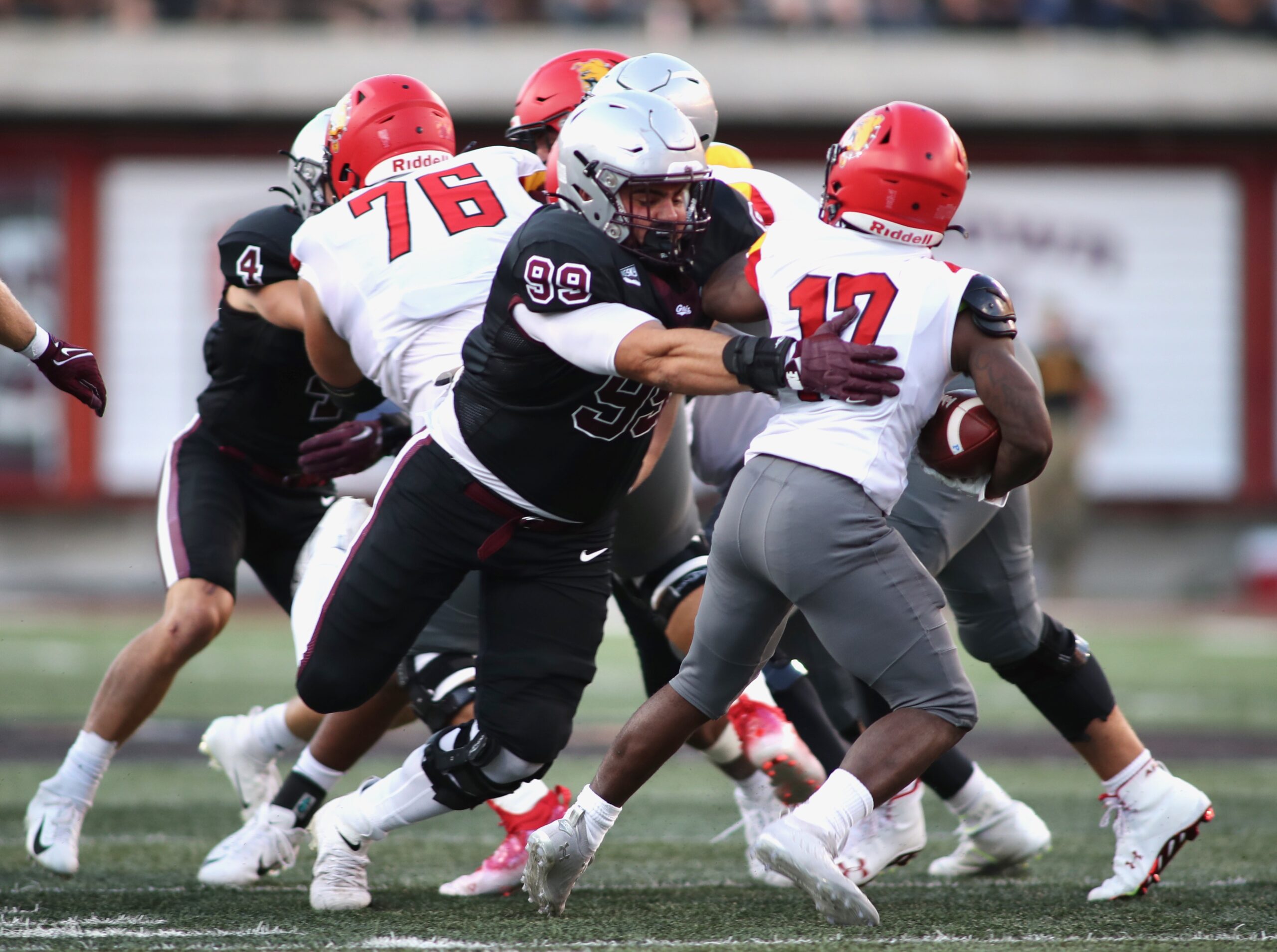
“You’ve probably heard the term when people talk about D-linemen, the term dancing bear,” the second coach said. “I think some of it is that he’s really good. But also some of it is the scheme. He’s not an elite pass rusher, but he’s quick enough, and he can get on an edge and just really dent the offensive front. There’s so much movement, it’s hard to get double teams, especially on the interior when you’re set. Usually your center’s involved in some sort of double team, and you just can’t do that because there’s always movement, and it’s not just Gubner that’s moving. It’s the other guys with him.
“So you’re having to pass off multiple twists, which eliminates the ability to double team and then he just plays with such good leverage that you know, he’s gonna be on an edge because you can’t double team and he moves too much to block him straight up. He just does a great job slanting, and it’s only like a one-gap or a half-gap slant. But man, then he gets low and gets vertical and so your pullers get knocked off their track. He’s already penetrating the pocket from the interior which is the toughest type of pass rush, even if he’s not getting home. I’m not saying he’s Aaron Donald, but there’s a reason Aaron Donald’s the biggest problem in the NFL up front.
“Everybody wants a left tackle now, but I’ll tell you what, a defensive end is way easier to handle than a really talented interior guy, right? Because a defensive end, you can chip him, you can align with them. You can have the tailback shadow him, but an interior D-lineman who can go either way, and is going to be likely going against a guard or a center who starts with his hand on the ground, is a problem. … It’s a lot easier to generate one-on-ones schematically on the interior of the offensive line, but very rarely are there guys that are that athletic enough to create problems, and stout enough to hold up in the run game.”
That coach also weighed in on the Griz linebackers and secondary.
“Every year, Montana schematically is going to help their ‘backers out so much because of the line games and just the sheer size that they have up front,” he said. “They’ve really been able to recruit to that system, their ‘backers are always going to be free. You’re never worried about any of their linebackers, you’re worried about the games up front that free up the linebackers, if that makes sense.”
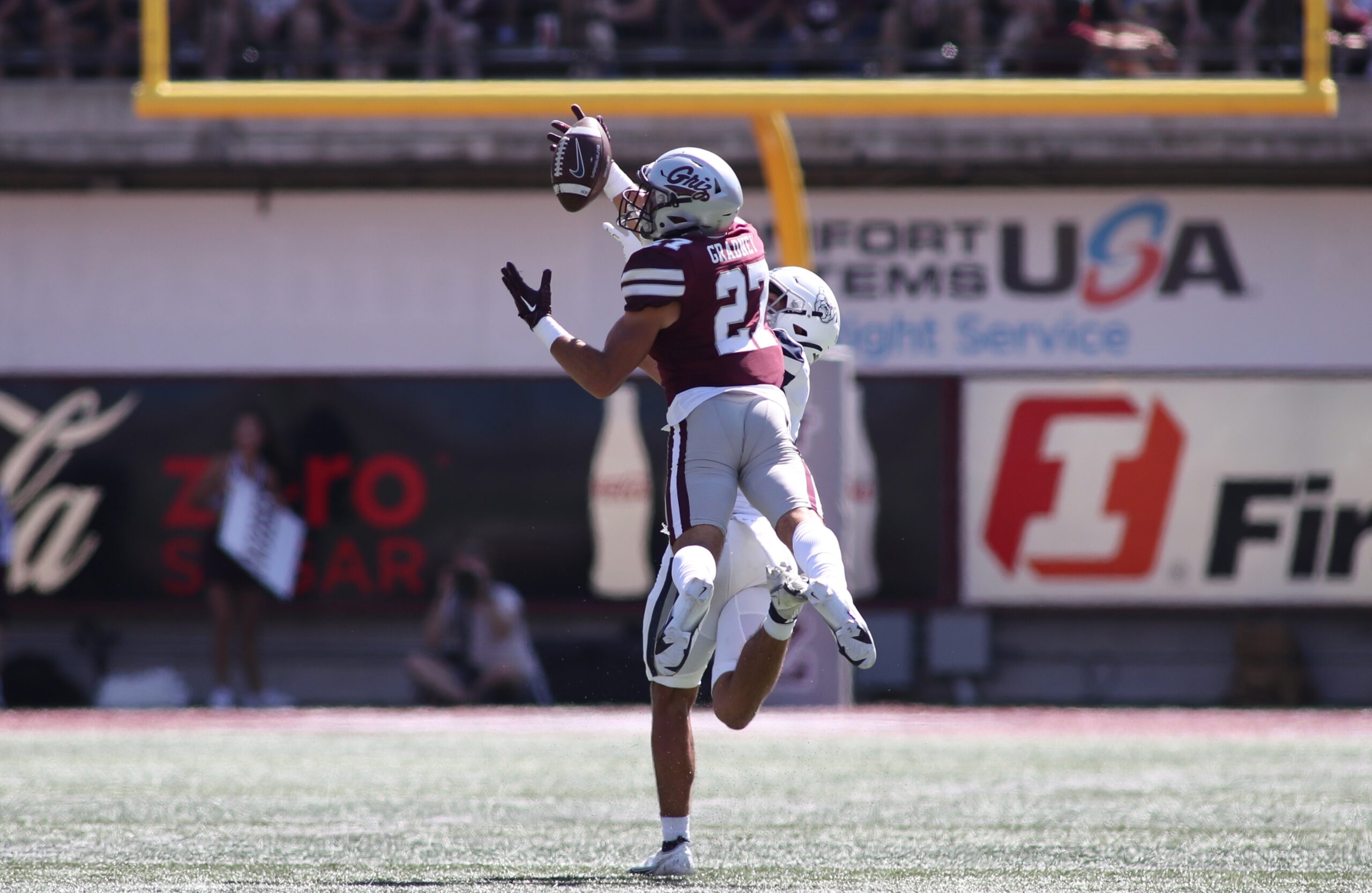
As for the corners – Trevin Gradney to the boundary and Corbin Walker to the field side – he said: “Depending on how well the Jacks can run the ball, those guys are going to be a little bit on an island. I think No. 27, Gradney, does a great job. He’s so frickin long that he would reroute guys and guys would be having to get the ball out quick. He’s so long that he gets hands on guys, so he disrupts the route and then he gets his eyes on the quarterback and the ball, and the quarterback’s having to move. … I think South Dakota State will throw to the field because Gronowski has the arm to do it. It’s not because (Walker) is the worst cover guy. He just gets less help. So that’s where you would want to go throwing one-on-one.
“I think if you’re playing against the Griz, if this is me, you’re going to try and get in a wing run game. You’re going to try and get two (receivers) out into the boundary. You might even see some wing slot into the boundary where you have two tight ends to the field and two receivers into the boundary. That’s kind of a funky formation that people have done, or getting in 11 personnel where you have one tight end to the field and then two receivers into the boundary. That’s something people use to attack the Griz a lot, because that’ll allow South Dakota State to run the run game they want but still give them some advantages in the pass game.

“They’re gonna have to take the throws underneath when they can, but neither of these teams wants to beat you by throwing the football, dropping back. So the old adage of whoever stops the run will be interesting to see. It’ll be interesting to see how the Griz handle Jimmy up front, because they’re gonna try and make Clifton (McDowell) run the ball. He’s done a good job of that. I just don’t know if that’s the way they want to win the game. … South Dakota State, on the whole, traditionally has always been more of a team that’s more willing to make adjustments. It will be interesting to see if Montana deviates from the plan or just does what they do.
“Can Montana have enough wrinkles to give Jimmy problems, because if they don’t try something new, Jimmy will have them dialed up. And how quickly can the Griz on defense adjust to how South Dakota State wants to attack them, or they can South Dakota State attack them formation boundary? Are they going to use quarterback run game to get the extra gap? Or are they going to try and throw it into the boundary? I don’t know. But it’ll be interesting to see because South Dakota State will have some wrinkles. Montana has less of a wrinkle team. They’re more of a we do what we do, but they do it really well. So it’ll be a fun game to watch. I think it’s probably the FCS game I’m most excited for in a long time.”


